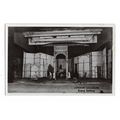St. Michaels Mount, Cornwall - entrance gateway - Frith postcard c.1920s
- Condition : Used
- Dispatch : 2 Days
- Brand : None
- ID# : 128784868
- Quantity : 1 item
- Views : 263
- Location : United Kingdom

- Seller : justthebook (+1703)
- Barcode : None
- Start : Sat 07 Jun 2014 18:28:21 (EDT)
- Close : Run Until Sold
- Remain : Run Until Sold
Checks/Cheques
 for 1 item(s) edit
for 1 item(s) edit
Shipping Calculator
More Listings from This Seller view all
Seller's Description
- Postcard
- Picture / Image: St. Michael's Mount, Cornwall - the entrance gateway - slightly less common view of the landmark
- Publisher: Friths series
- Postally used: no
- Stamp: n/a
- Postmark(s): n/a
- Sent to: n/a
- Notes / condition: couple of very minor marks on reverse
Please ask if you need any other information and I will do the best I can to answer.
Image may be low res for illustrative purposes - if you need a higher definition image then please contact me and I may be able to send one.
------------------------------------------------
Postage & Packing:
Postage and packing charge should be showing for your location (contact if not sure).
No additional charges for more than one postcard. You can buy as many postcards from me as you like and you will just pay the fee above once. (If buying postcards with other things such as books, please contact or wait for invoice before paying).
Payment Methods:
UK - PayPal, Cheque (from UK bank) or postal order
Outside UK: PayPal ONLY (unless otherwise stated) please. NO non-UK currency checks or money orders (sorry).
NOTE: All postcards are sent in brand new stiffened envelopes which I have bought for the task. These are specially made to protect postcards and you may be able to re-use them. In addition there are other costs to sending so the above charge is not just for the stamp!
I will give a full refund if you are not fully satisfied with the postcard.
----------------------------------------------
Text from the free encyclopedia WIKIPEDIA may appear below to give a little background information (internal links may not work) :
*************
St Michael's Mount (Cornish: Karrek Loos yn Koos,[1] meaning ""grey rock in the woods"", also known colloquially by locals as simply the Mount) is a tidal island 366 m (400 yd) off the Mount's Bay coast of Cornwall, England, United Kingdom. It is a civil parish and is united with the town of Marazion by a man-made causeway of granite setts, passable between mid-tide and low water.
The island has a mix of slate and granite (see Geology below). Its Cornish language name – literally, ""the grey rock in the wood"" — may represent a folk memory of a time before Mount's Bay was flooded. Certainly, the Cornish name would be an accurate description of the Mount set in woodland. Remains of trees have been seen at low tides following storms on the beach at Perranuthnoe, but radiocarbon dating established the submerging of the hazel wood at about 1700 BC.[2] The chronicler John of Worcester[3] relates under the year 1099 that St. Michael's Mount was located five or six miles (10 km) from the sea, enclosed in a thick wood, but that on the third day of November the sea overflowed the land, destroying many towns and drowning many people as well as innumerable oxen and sheep; the Anglo-Saxon Chronicle records under the date 11 November 1099, ""The sea-flood sprung up to such a height, and did so much harm, as no man remembered that it ever did before"".[4] The Cornish legend of Lyonesse, an ancient kingdom said to have extended from Penwith toward the Isles of Scilly, also talks of land being inundated by the sea.
In prehistoric times, St Michael's Mount may have been a port for the tin trade, and Gavin de Beer made a case for it to be identified with the ""tin port"" Ictis/Ictin mentioned by Posidonius.[2]
Historically, St Michael's Mount was a Cornish counterpart of Mont Saint-Michel in Normandy, France (which shares the same tidal island characteristics and the same conical shape), when it was given to the Benedictines, religious order of Mont Saint-Michel, by Edward the Confessor in the 11th century.[5]
St Michael's Mount is one of 43 (unbridged) tidal islands which can be walked to from mainland Britain.[6]
The Mount may be the Mictis of Timaeus, mentioned by Pliny the Elder in his Naturalis Historia (IV:XVI.104), and the Ictis of Diodorus Siculus.[citation needed] Both men had access to the now lost texts of the ancient Greek geographer Pytheas, who visited the island in the fourth century BC. If this is true, it is one of the earliest identified locations in the whole of western Europe and particularly on the island of Britain, although the account of John of Worcester in the 11th century would point to this association being very unlikely.
It is claimed that St. Michael, the Archangel appeared to local fishermen on the Mount in the fifth century AD,[7] which according to author Richard Freeman Johnson is perhaps a nationalistic twist to a myth.[8]
It may have been the site of a monastery in the 8th – early 11th centuries and Edward the Confessor gave it to the Norman abbey of Mont Saint-Michel.[9] It was a priory of that abbey until the dissolution of the alien houses by Henry V, when it was given to the abbess and Convent of Syon at Isleworth, Middlesex. It was a resort of pilgrims, whose devotions were encouraged by an indulgence granted by Pope Gregory in the 11th century.
The monastic buildings were built during the 12th century and in 1275 an earthquake destroyed the original priory church, which was rebuilt in the late 14th century. It is still in use today. The priory was seized by the Crown, when Henry V went to war in France and it became part of the endowment for the Brigittine Abbey of Syon at Twickenham in 1424. Thus ended the connection with Mont St Michel.[9][10]
Henry Pomeroy captured the Mount, on behalf of Prince John, in the reign of Richard I. John de Vere, 13th Earl of Oxford, seized and held it during a siege of 23 weeks against 6,000 of Edward IV's troops in 1473. Perkin Warbeck occupied the Mount in 1497. Humphry Arundell, governor of St Michael's Mount, led the rebellion of 1549. During the reign of Queen Elizabeth I, it was given to Robert Cecil, Earl of Salisbury, by whose son it was sold to Sir Francis Basset. During the Civil War, Sir Arthur Basset, brother of Sir Francis, held the Mount against the parliament until July 1646.
In 1755 the Lisbon earthquake caused a tsunami to strike the Cornish coast over 1,000 miles (1,600 km) away. The sea rose six feet in 10 minutes at St Michael's Mount, ebbed at the same rate, and continued to rise and fall for five hours. The 19th-century French writer Arnold Boscowitz claimed that ""great loss of life and property occurred upon the coasts of Cornwall.""[11]
In the late 19th century the skeleton of an anchorite was discovered when a chamber was found beneath the castle's chapel.[citation needed] When the anchorite died of illness or natural causes, the chamber had been sealed off to become his tomb.[citation needed] The Mount was sold in 1659 to Colonel John St Aubyn. His descendant, Lord St Levan, continues to be the ""tenant"" of the Mount but has ceased to be resident there, his nephew, James St Aubyn, taking up residency and management of the Mount in 2004.
Little is known about the village before the beginning of 18th century, save that there were a few fishermen's cottages and monastic cottages. After improvements to the harbour in 1727, St Michael's Mount became a flourishing seaport, and by 1811 there were 53 houses and four streets. The pier was extended in 1821[12] and the population peaked in the same year, when the island had 221 people. There were three schools, a Wesleyan chapel, and three public houses, mostly used by visiting sailors. The village went into decline following major improvements to nearby Penzance harbour and the extension of the railway to Penzance in 1852, and many of the houses and buildings were demolished.
The Mount was fortified during the Second World War during the invasion crisis of 1940–41. Three pillboxes can be seen to this day.[13]
Sixty-five years after the Second World War, it was suggested based on interviews with contemporaries that the former Nazi foreign minister and one time ambassador to Britain, Joachim von Ribbentrop, had wanted to live on the Mount after the planned German conquest. Archived documents revealed that during his time in Britain in the 1930s, in which he had initially proposed an alliance with Nazi Germany, Ribbentrop frequently visited Cornwall.[14]
In 1954, the 3rd Baron St Levan gave most of St Michael's Mount to the National Trust, together with a large endowment fund.[citation needed] The St Aubyn family retained a 999-year lease to inhabit the castle and a licence to manage the public viewing of its historic rooms. This is managed in conjunction with the National Trust.
Until recent times both the Mount and the town of Marazion formed part of the parish of St Hilary.[5] St Michael's Mount forms its own civil parish for local government purposes. Currently, this takes the form of a parish meeting as opposed to a parish council (that is, a yearly meeting of electors that does not elect councillors). The current chairman of the St Michael's Mount parish meeting is James St Aubyn.
The chapel is extra-diocesan, and the castle is the official residence of Lord St Levan. Many relics, chiefly armour and antique furniture, are preserved in the castle. The chapel of St Michael, a fifteenth-century building, has an embattled tower, in one angle of which is a small turret, which served for the guidance of ships. Chapel Rock, on the beach, marks the site of a shrine dedicated to the Virgin Mary, where pilgrims paused to worship before ascending the Mount. A few houses are built on the hillside facing Marazion, and a spring supplies them with water.
Some studies indicate that any rise in ocean waters as well as existing natural erosion would put some of the Cornwall coast at risk, including St. Michael's Mount.[15]
There is a row of eight houses at the back of the present village; they were built in 1885 and are known as Elizabeth Terrace. A spring supplies them with water. Some of the houses are occupied by staff working in the castle and elsewhere on the island.
The island cemetery (currently no public access) contains the graves of former residents of the island and several drowned sailors. There are also buildings that were formerly the steward's house, a changing-room for bathers, the stables, the laundry, a barge house, a sail loft (now a restaurant), and two former inns. A former bowling green adjoins one of the buildings.
One of the most noteworthy points of interest on the island is the island's own underground railway, which is still used to transport goods from the harbour up to the castle. It was built by tin miners around 1900, replacing the pack horses which had previously been used. Due to the steep gradient, it cannot be used for passengers. The National Trust currently does not permit public access or viewing of the railway.
The harbour, widened in 1823 to allow vessels of 500 tons to enter, has a pier dating from the fifteenth century which was subsequently enlarged and restored. Queen Victoria landed at the harbour from the royal yacht in 1846, and a brass inlay of her footstep can be seen at the top of the landing stage. King Edward VII's footstep is also visible near the bowling-green. In 1967 the Queen Mother entered the harbour in a pinnace from the royal yacht Britannia.
type=printed postcards
theme=topographical: british
sub-theme=england
county/ country=cornwall/ scilly isles
number of items=single
period=inter-war (1918 - 1939)
postage condition=unposted
Listing Information
| Listing Type | Gallery Listing |
| Listing ID# | 128784868 |
| Start Time | Sat 07 Jun 2014 18:28:21 (EDT) |
| Close Time | Run Until Sold |
| Starting Bid | Fixed Price (no bidding) |
| Item Condition | Used |
| Bids | 0 |
| Views | 263 |
| Dispatch Time | 2 Days |
| Quantity | 1 |
| Location | United Kingdom |
| Auto Extend | No |




















